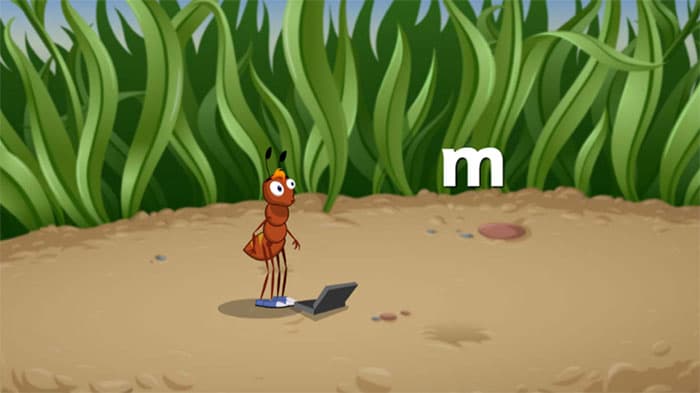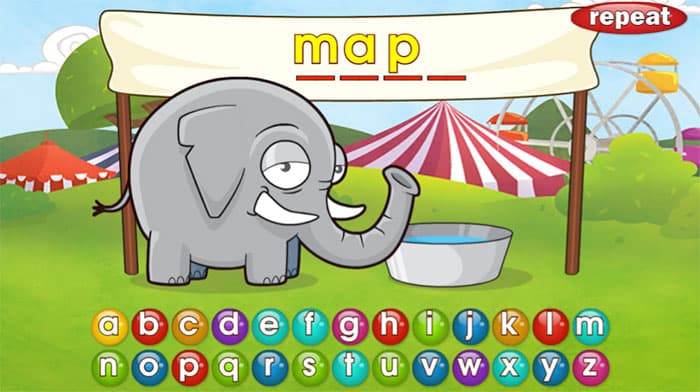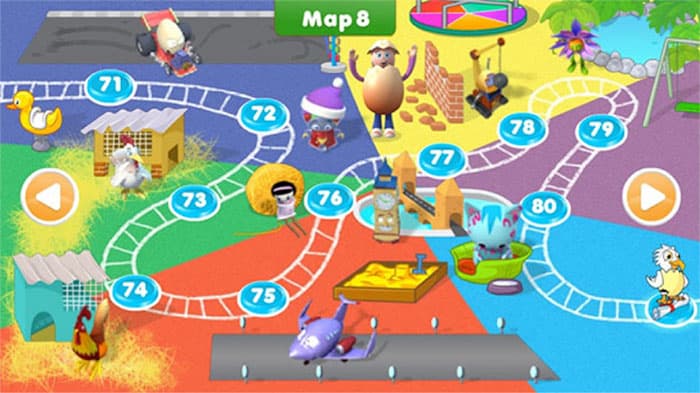


Dyslexia and Reading: Sounds, Letters, Rules and Fluency

Children with dyslexia can learn to read fluently with the right instructional approach.
Explicit and systematic instruction which develops sound-letter awareness and an understanding of how written language works is a great way to build reading fluency in children with dyslexia.
Learning to read with dyslexia
Dyslexia is a difference in the way the brain processes language, ranging from mild to severe.
It's important for parents and teachers to note that dyslexia is not linked to low intelligence, hearing or vision problems, or any other factors for that matter. With the right instructional approach, all children with dyslexia can learn to read fluently.
Children with dyslexia are usually lacking in phonemic awareness. This is a recognition that words are made up of individual sounds which can then be represented by written letters and spelling patterns.
Try the award-winning programme for FREE
Reading Eggs is the multi-award winning programme that helps children of all abilities learn how to read.
All children need to build phonemic awareness before they learn to read. Without it, it makes blending and segmenting sounds and letters extremely difficult.
For some children, poor orthographic coding can also be part of the problem. Orthography is the set of conventions for writing a language, such as standardised spelling, punctuation, capitalisation and so on. If a child does not grasp these writing ‘rules’ it is difficult to read fluently and for meaning.
Recent research indicates that individuals with a language learning disability, such as dyslexia, also struggle with morphological awareness – being able to break down unknown words into base words, suffixes and prefixes in order to work out their meaning. This is another barrier to reading for comprehension.
Building phonemic awareness and phonics in children with dyslexia

Reading Eggs has a huge focus on building phonemic awareness, and the best part is it progresses at each child’s individual pace. Free trial
Whereas most pre-school children (4–5 years old) can aurally recognise a word’s starting sound and ending sound, children with dyslexia may struggle with this.
For example, asking them to tell you a word that rhymes with ‘hat’, or a word that starts with ‘mmm’, may just be too hard for them.
Early school years students (6–7 years old) will be expected to ‘sound out’ a word and write down the corresponding letters for each sound, e.g. buh/ah/tuh – bat. A child with dyslexia may struggle to identify the individual sounds, let alone link them to a written letter.
Successful programmes that teach children with dyslexia how to read start with a strong focus on phonological awareness, the understanding that speech is broken into individual sounds, e.g. cat – kuh/ah/tuh. This is the basis for understanding how language is formed.
Try the award-winning programme for FREE
Reading Eggs is the multi-award winning programme that helps children of all abilities learn how to read.
Once children have grasped this concept, phonics skills can be developed – linking the sounds to letters. For example, the sound ‘ssss’ in ‘see’ is represented by the letter s, whereas the sound ‘shhh’ in ‘sheep’ is represented by sh.
These two pre-reading elements – phonemic awareness and phonics skills – may take longer than usual to develop in a child with dyslexia. They may not develop at all without systematic, explicit and repetitive instruction.
Teaching spelling rules for children with dyslexia and reading difficulties
While phonics instruction can teach a child to read words, reading for comprehension relies on more than just decoding letters into sounds.
Research strongly supports the idea that children with dyslexia benefit from being explicitly taught language conventions, which add to the meaning of words and sentences. Orthography covers standardised spelling rules, such as how to create plurals, for example, adding s or es: cat – cats, bus – buses.
It also looks at the exceptions to these rules, such as making irregular nouns into plurals, for example, mouse – mice, sheep – sheep.
Learning how standardised punctuation and capitalisation rules add meaning is important for comprehension. This is a classic example of a missing comma changing the meaning: Let’s eat grandpa. As opposed to: Let’s eat, grandpa.

Reading Eggs uses carefully structured lessons to build essential spelling skills in children of all reading abilities. Free trial
Morphology
Another effective strategy for teaching children to decode unknown words is morphological awareness – breaking larger words into base words, suffixes and prefixes in order to work out their meaning using their parts.
Note: This knowledge is emphasised in The Knowledge and Practice Standards for Teachers of Reading developed by the International Dyslexia Association.
A recent look at studies on morphological awareness intervention stated that this "may be an especially important skill to improve reading success for students at risk for or diagnosed with specific learning disabilities such as dyslexia … as this skill promotes written word decoding and identification".
Some examples of decoding words using morphemes:
muddy – take the base word mud and the suffix -y to create an adjective.
unkind – the prefix un- turns the base word kind into its opposite – not kind, mean, cruel.
jellybean – a compound word made of two bases meaning a bean shape made of jelly.
How Reading Eggs helps children with dyslexia learn how to read
Reading Eggs is a structured online learn-to-read programme that offers personalised instruction in an engaging manner, benefiting children of all abilities and learning styles.
A placement test ensures the children start at the optimal level, and only move on when they have grasped each lesson.
The lessons in Reading Eggs explicitly and systematically teach early reading concepts. The sequence of lessons builds active reading comprehension skills. Children will progress from learning to spell and decode words and their meanings to fluent reading for comprehension.

Reading Eggs uses carefully structured lessons to build essential spelling skills in children of all reading abilities. Free trial
The animated, interactive lessons in Reading Eggs begin with phonemic skills – identifying beginning sounds and rhyming words, matching sounds and letters, sounding out words, segmenting and blending sounds and letters.
Later lessons build on these phonemic skills to include orthography and morphology – spelling rules, punctuation, suffixes, prefixes and compound words.
This self-paced programme has a variety of fun interactive activities presented as games. These provide the repetition needed for the skills and knowledge to become part of the child’s long-term memory, without letting them get bored.
Each Reading Eggs lesson ends with a book matched to the student’s current ability, which lets them enjoy the thrill of reading on their own. They can choose to have the book read to them, then reread the book to themselves. There are over 3500 levelled books for your child to practise their reading.
See how Reading Eggs works
We offer all new parents a free trial to see how Reading Eggs works for their child.
It only takes a few minutes to get started.
Try Reading Eggs here to see how your child’s reading and comprehension skills can improve in just weeks.
Reading Eggs testimonials for children with dyslexia
“Reading Eggs has been the best purchase for our homeschool this year. Our 8-year-old dyslexic son loves and learns from this visually exciting programme. It has helped his reading and also his writing as he has started his own ‘Reading Eggs’ story book! He draws his own map, creates characters for each level and writes a story for each one. Amazing!”
– Edyth N.
"Wonderful! My 10-year-old son has dyslexia and has finally learned to read, albeit slowly in our local language. English is the language we speak at home and I thought I would give Reading Eggs a try, while putting NO pressure on him to do it. He asks to do Reading Eggs several times a week! He is on Lesson 39. I know he is progressing because of the progress reports (I dare not look over his shoulder!) Thank you for the programme!”
– Shoshana G.
Karande, S. & Agarwal, A. (2017) Ophthalmic abnormalities in children with dyslexia: A look at current research. Journal of Postgraduate Medicine, 63(1), 1-3, doi: 10.4103/0022-3859.198138, retrieved from https://www.ncbi.nlm.nih.gov/pmc/articles/PMC5394809/
Wolter, J.A. & Collins, G. (2017) Morphological Awareness Intervention for Students Who Struggle with Language and Literacy. Perspectives on Language and Literacy, 43(2), 17-22, retrieved from https://search.proquest.com/openview/e8b15bf5288275c47fba9347f0cd2364/1?pq-origsite=gscholar&cbl=28091
International Dyslexia Association. (2010). Knowledge and Practice Standards for Teachers of Reading. Section B(7), retrieved from https://dyslexiaida.org/knowledge-and-practices/
Wolter, J.A. & Collins, G. (2017) Morphological Awareness Intervention for Students Who Struggle with Language and Literacy. Perspectives on Language and Literacy, 43(2), 17, retrieved from https://search.proquest.com/openview/e8b15bf5288275c47fba9347f0cd2364/1?pq-origsite=gscholar&cbl=28091






